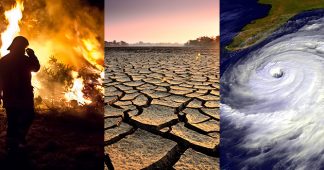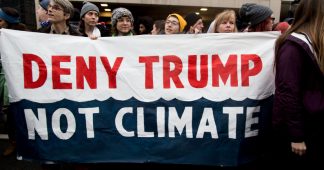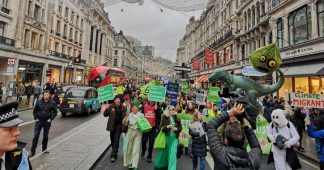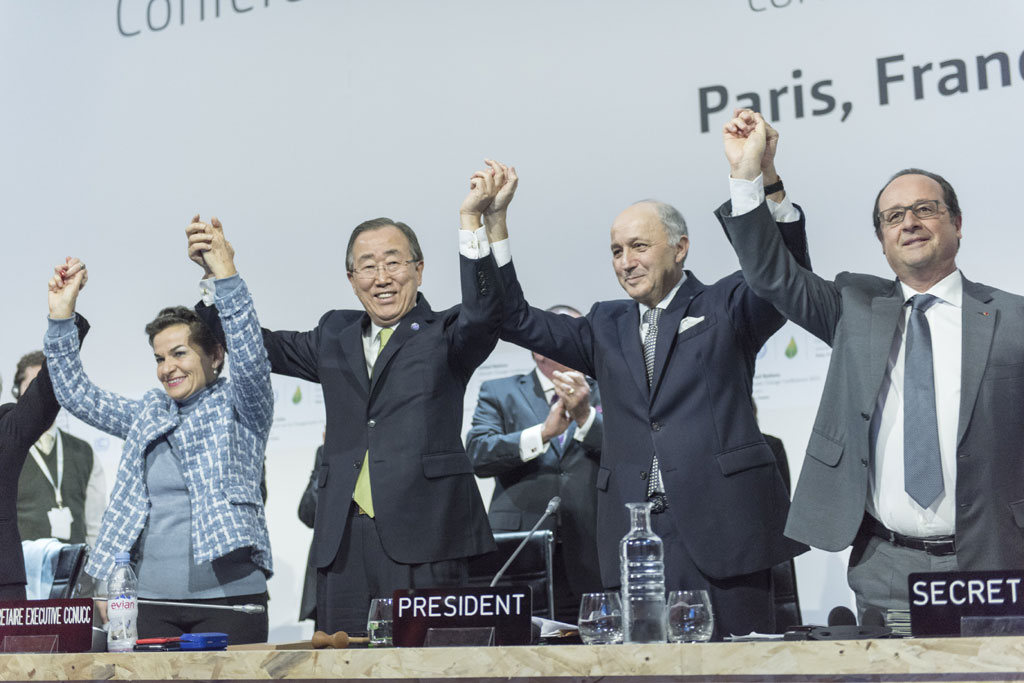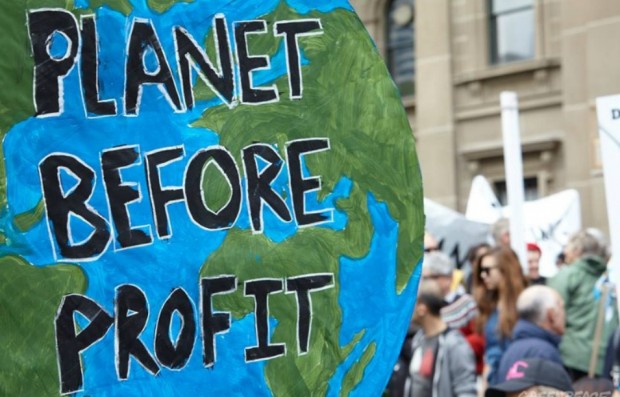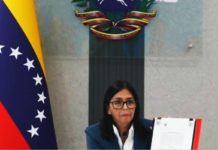COP24: Achieving Nothing, Cementing a Trend
By D. Raghunandan
20 Dec 2018
The 24th Conference of Parties (COP 24) to the international climate control process held in the Polish town of Katowice (pronounced Kaato-veetsa) [ns1] concluded last Saturday, after an extension by a day to iron out remaining differences, as has become customary by now. The banging of the Chairman’s gavel signaling consensus on the COP 24 declaration text was greeted by the usual scenes of exultation, including a dramatic leap from podium to the ground by the COP 24 Chair, Poland’s Minister Michal Kurtyka, as if some great triumph had been recorded against all odds. But, in reality, he was simply expressing sheer relief at the end of another painful ordeal in the continuing saga of climate COPs, with little of substance to show at the end of it.
Readers will pardon a cynicism not usual in these columns over the years, but the climate COPs are increasingly spending most of the time of many tens of thousands of official delegates, NGOs and other observers, and hundreds of thousands of activists milling around the COP venues, in discussing the finer points of ancillary, even if important, issues, while the core issue of looming, irreversible and disastrous climate change continues to languish without any significant advance, bringing the world almost to the tipping point, even as COP after COP passes by.
It is becoming clearer by the day that this trend is not only getting cemented in the COPs, but is being deliberately encouraged if not engineered by developed countries led by the US which, despite having announced its withdrawal from the Paris Agreement (PA), continues to exert outside influence on COP deliberations and decisions. Consequently, the climate COPs have turned into an institutional framework that now decisively favours, and is driven by, the global North.
COP 24 Agenda
The main agenda at Katowice was drawing up the Rulebook for reporting, monitoring and assessing emissions reduction commitments made under the Paris Agreement such that performance of different countries may be reported in a common format, properly assessed, and compared with each other, and totaled so as to estimate where the world has reached with regard to the goal of keeping temperature rise “well under 2 degrees C”.
The Rulebook was indeed successfully finalised, but only after diluting several provisions and kicking many important issues down the road, as discussed below. Similarly, there were also the usual inconclusive and contentious discussions on financial assistance, and compensation for loss and damage due to climate change. And there were uncomfortable periods when some notorious climate deniers decided not to support a resolution “welcoming” the IPCC’s Special Report on the aspirational but highly misleading goal of 1.5 degrees C. A lot to digest, you might think, and rightly so.
What was NOT discussed at Katowice, however, was the dominant concern around the world, namely the main PA goal of 2 degrees C with all its latter-day qualifiers, collectively voiced over many COPs since Copenhagen, but which the world is tragically still so far away from.
The Rulebook
On the face of it, the Rulebook agreed upon at COP 24 covered most of the areas proposed to be taken up under it. However, it should be noted upfront that almost all of these pertain to procedures of reporting, rather than substantive issues of emission reduction measures, although some of these were touched upon, only to be shelved later.
Under the agreed Rulebook, all countries will have to report their emissions, and progress in reducing them, once every two years starting from 2024, a good four years after PA comes into effect.
In broad terms, the Rulebook specifies a single set of rules for all countries, whereas there had been demands earlier that some categories of developing countries be permitted less stringent procedures for reporting, an issue that had bedeviled discussions for several years regarding submissions of national emissions inventories. Countries are required to follow the IPCC 2006 guidelines, last updated in 2006, but henceforth being updated every year, which should not be difficult to follow. (Incidentally, the revised IPCC guidelines ascribe higher global warming potential to Methane than earlier, 28 times that of carbon dioxide compared with 21 before, emanating mainly from paddy fields, cattle and other ruminant animals, and from waste, already a rapidly rising green-house gas especially in growing developing countries such as India.)
Finally, however, countries without necessary capacities were granted wide latitude. Some scientists have criticised this hedge around scientifically robust accounting methods and leeway to use “nationally appropriate methodologies.” It should be borne in mind, however, that while 192 countries participated in these discussions, around 30-40 countries account for the overwhelming proportion of global emissions, so this flexibility should not affect the overall assessment of adequacy in meeting set goals.
The most contentious areas, both procedurally and substantively, were those dealing with rules for voluntary market mechanisms, including trading over-achievement of pledges, and generation of saleable carbon credits by individual projects. Readers may recall that similar measures had badly undermined the Kyoto Protocol virtually wiping out its already low emission reduction targets, allowing developed countries to “offset” their own emission cuts for indeterminate tree-plantation in developing countries, and permitting former Soviet bloc countries to trade their “hot air,” i.e. the economic growth they may have had under Socialism compared with afterwards!
At COP24, the main dispute was over “double counting” of offsets by both buyers and sellers. Brazil, under the new Right-wing government, proved to be extremely stubborn, taking a “Brazil versus the rest of the world” position, as one delegate put it, looking for flexibility on this issue, enabling it to trade on significant parts of the Amazon forests. The COP was also unable to resolve issues relating to if and how to carry forward the offsets, schemes and methodologies of the Clean Development Mechanism to the PA and its Rulebook.
Yet another related vexed issue was “overall mitigation in global emissions” (OMGE). It had been agreed in Paris that, in order to overcome these key weakness of the Kyoto Protocol, emissions trading should result in net global emissions reductions, not in a zero sum game, with rise in emissions in one country being offset by reductions in another. One suggestion mooted in Katowice was that 30% of offsets be automatically written-off to ensure net emission gains. But later versions saw “voluntary cancellations” make a back-door entry leading to yet another stand-off.
Ultimately, the disputed points became far too many to resolve, and the COP kicked the whole can of emissions trading, carbon credits etc. down the road to next year!
Finances
Climate finances remained as contentious an issue as ever, including as relating to the Rulebook for reporting and transparency. Hundred billion dollars annually have been pledged by developed countries since Copenhagen in 2009, and is enshrined in the Paris Agreement, but by all accounts, remains a distant dream. The sourcing of these funds, as well as their distribution between mitigation and adaptation, are equally contentious, and remain so.
The rules cover both funds projected as becoming available in the near future as well as funds that have already been transferred. The version emerging towards the end of the two weeks said developed countries “shall” report any funds they provide, while developing countries “should” report such funding, recognising both the latter fund flows, e.g. from China or India, and providing for some differentiation for them.
Yet, controversially as always, the language of the rules provides huge leeway to developed countries along the lines they have always been insisting upon, by refusing to distinguish between grant and loan finances, allowing the full value of the latter to be reported as “climate finance” rather than only the grant-equivalent portion as demanded by developing countries and many neutral observers.
On the eve of COP 24, the Organisation of Economically Developed Countries (OECD) released a report on climate finance for 2017, as it has been doing periodically, for example just before the Paris summit. The current report claims that public climate finance reached around $56.7 billion in 2017. A similar figure was touted by OECD in Paris, but was sharply refuted by developing countries, notably by India’s Finance Ministry which said the figure was closer to $2.2 billion!
Discussions remain inconclusive at the United Nations Framework Convention on Climate Change (UNFCCC) as to what constitutes climate finance, with reference to grants versus bilateral and multi-lateral loans, and the proportion of funding for mitigation to adaptation.
The OECD report admits that grants represent only around 30% of bilateral finance and less than 10% of multilateral finance, whereas loans were around 60% of bilateral finance and 90% of multilateral finance. Further, while figures appear to suggest a rise in climate financing, grants have risen by only around 25% while loans have shot up by 100%! All kinds of other fudging is also resorted to by the developed countries, such as showing export credits extended to developing countries as “climate finance,” a far cry from what it was meant to be!
Developing nations, especially small island states and other particularly vulnerable countries, have consistently demanded substantial additional funds for adaptation so as to cope with the already perceptible impact of climate change. However, the proportion is roughly constant at around 70% for mitigation and 20% for adaptation.
The part pertaining to climate financing that did not get through COP 24 was “loss and damage,” the provision that developing countries thought was a major breakthrough when it was first made in COP19 in Warsaw. While considerable energy was spent on arguing about the issue and appropriate language that would reflect an elusive consensus on it, developed countries continued to resist formalisation of any commitments related to it, on the grounds that this could potentially open the doors to legal liability, and possibly unlimited future compensation claims. This issue could not be resolved at COP 24 and, you guessed it, was also kicked down the road.
So that is where we are. Climate change is proceeding apace, with even the latest figures showing global emissions are still rising, belying the false hopes generated by a brief and tiny blip a couple of years ago. Since Paris, the COPs have not even seriously addressed the situation of below-par pledges by developed countries, failing to meet the set goal of limiting temperature rise to 2 degree C, even in the face of the inexorable march towards 3 to 3.5 degree C rise in temperature if current trends persist.
Even at COP 24, even as the vulnerable countries and small island states kept asking for raising emission reduction pledges, to complete deaf ears, the UN Secretary General promised that henceforth his efforts would focus on “more ambition, ambition, ambition, ambition, ambition.” Flying in the face of this harsh reality, and even pushed by these same vulnerable nations, the world seems to be captivated by the mirage of a 1.5 degree C goal, never mind how implausible it is, so much so that anyone questioning this goal would be tarred with the brush of under-ambition! The 1.5 degree C goal would require global emissions to peak by 2020, drop by 50% by 2030, and reach net zero by 2050. With Christmas around the corner, are we to believe in Santa Claus?
And meanwhile, developed countries are sitting on their haunches, not budging from their ridiculously low emission cut pledges, and with no substantial action to effectively fill the gap between the Kyoto Protocol expiring in 2013, and the Paris Agreement coming into effect in 2020. All while gaming the COP negotiations, converting climate finances to another loan scheme, and laughing all the way to the bank.
Published at https://www.newsclick.in/cop24-achieving-nothing-cementing-trend
